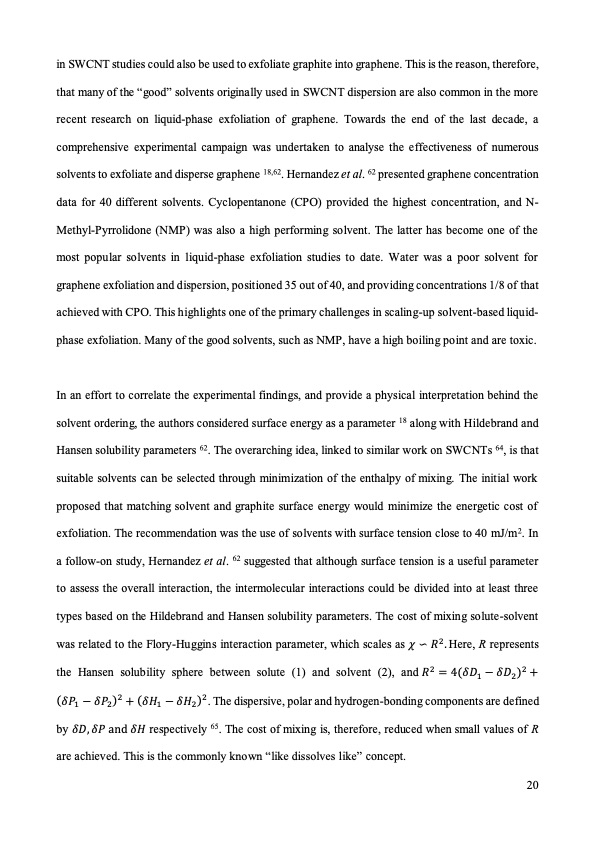
PDF Publication Title:
Text from PDF Page: 020
in SWCNT studies could also be used to exfoliate graphite into graphene. This is the reason, therefore, that many of the “good” solvents originally used in SWCNT dispersion are also common in the more recent research on liquid-phase exfoliation of graphene. Towards the end of the last decade, a comprehensive experimental campaign was undertaken to analyse the effectiveness of numerous solvents to exfoliate and disperse graphene 18,62. Hernandez et al. 62 presented graphene concentration data for 40 different solvents. Cyclopentanone (CPO) provided the highest concentration, and N- Methyl-Pyrrolidone (NMP) was also a high performing solvent. The latter has become one of the most popular solvents in liquid-phase exfoliation studies to date. Water was a poor solvent for graphene exfoliation and dispersion, positioned 35 out of 40, and providing concentrations 1/8 of that achieved with CPO. This highlights one of the primary challenges in scaling-up solvent-based liquid- phase exfoliation. Many of the good solvents, such as NMP, have a high boiling point and are toxic. In an effort to correlate the experimental findings, and provide a physical interpretation behind the solvent ordering, the authors considered surface energy as a parameter 18 along with Hildebrand and Hansen solubility parameters 62. The overarching idea, linked to similar work on SWCNTs 64, is that suitable solvents can be selected through minimization of the enthalpy of mixing. The initial work proposed that matching solvent and graphite surface energy would minimize the energetic cost of exfoliation. The recommendation was the use of solvents with surface tension close to 40 mJ/m2. In a follow-on study, Hernandez et al. 62 suggested that although surface tension is a useful parameter to assess the overall interaction, the intermolecular interactions could be divided into at least three types based on the Hildebrand and Hansen solubility parameters. The cost of mixing solute-solvent was related to the Flory-Huggins interaction parameter, which scales as 𝜒 ∽ 𝑅2. Here, R represents the Hansen solubility sphere between solute (1) and solvent (2), and 𝑅2 = 4(𝛿𝐷1 − 𝛿𝐷2)2 + (𝛿𝑃1 − 𝛿𝑃2)2 + (𝛿𝐻1 − 𝛿𝐻2)2. The dispersive, polar and hydrogen-bonding components are defined by 𝛿𝐷, 𝛿𝑃 and 𝛿𝐻 respectively 65. The cost of mixing is, therefore, reduced when small values of R are achieved. This is the commonly known “like dissolves like” concept. 20PDF Image | graphene production via nonoxidizing liquid exfoliation

PDF Search Title:
graphene production via nonoxidizing liquid exfoliationOriginal File Name Searched:
Graphene-R2-review.pdfDIY PDF Search: Google It | Yahoo | Bing
Salgenx Redox Flow Battery Technology: Power up your energy storage game with Salgenx Salt Water Battery. With its advanced technology, the flow battery provides reliable, scalable, and sustainable energy storage for utility-scale projects. Upgrade to a Salgenx flow battery today and take control of your energy future.
| CONTACT TEL: 608-238-6001 Email: greg@infinityturbine.com | RSS | AMP |